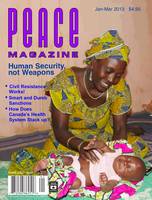
Peace Magazine January-March 2013, page 19. Some rights reserved.
Search for other articles by International Peace Bureau here
Money spent on the military isn’t available for addressing other human problems. That should be obvious but when environmentalists or development planners meet, they rarely even mention diverting money from the military to better uses. But the International Peace Bureau doesn’t overlook the connection, and now its secretary general, Colin Archer, has written another publication, “Opportunity Costs: Military Spending and the UN’s Development Agenda,” with Annette Willi to remind us all. Here are some highlights.
World military spending in 2011 reached an all-time record of $1738 billion. The United States, despite a decrease of 1.2 compared to 2010, is still leading the list of the top spenders, with its expenses totaling $711 billion. The pie chart shows the distribution of spending among eight other countries.
Between 1998 and 2010 global military expenditure increased each year, and following the 9-11 attacks the annual increase between 2001 and 2009 rose to 5.
While 2011 marks the global record in absolute totals, it is also the first year without a significant global increase, mainly due to many countries decreasing their military budgets in the wake of the economic crisis and making general reductions in government spending. This general tendency is described as “flattening out” rather than a serious downturn. It is too early to say if this will constitute a sustained trend.
As for arms production and the military services industry, sales have continuously gone up, reaching around $411.1 billion in 2011. If the increase between 2010 and 2011 is smaller than usual, it is mainly due to the US drawdown from Iraq.
The amount of money spent on the defence sector equals $4.7 billion a day or $249 per person. According to the World Bank and the Office of Disarmament Affairs (ODA), only about 5 of this amount would be needed each year to achieve the Millennium Development Goals by 2075.
While the bulk of the world’s military expenditure total is accounted for by the “big spenders,” it is often poorer countries who apportion the largest percentages of their government spending to defence. Here the opportunity costs are the most acute and immediate for the populations concerned, in terms of schools and clinics not opened, poverty programs not funded, etc. Low income states in general are less stable and are located in conflict-affected regions. Within the nation, a vicious circle tends to operate, whereby authoritarian military government and social inequality give rise to rebellion, which if it turns violent in response to repression, then justifies higher military spending and arms purchases, further reinforcing the regime in power.
For the price of one aircraft carrier ($5 billion), an area three times the size of Costa Rica could be reforested in the Amazon ($300 per hectare). Or for the cost of one battle tank ($780,000), 26,000 people could be treated for malaria ($30 per person). Yet many still suffer from this disease and thee speed at which the Brazilian Amazon is deforested, with about 7000 square km disappearing each year, is breathtaking.
The 192 governments present at the July 2012 UN Conference on Sustainable Development adopted the outcome document, The Future We Want. Eradicating poverty is described as the biggest challenge facing the world and the implementation of the three principles of sustainable development are reaffirmed: economic growth, social equality, and environmental sustainability. The 49-page document does not, unlike its older brother Agenda 21, include any mention of peace and security, nor disarmament. Nevertheless, a tremendous mobilization is underway on all continents to focus the world’s attention on the challenges ahead in poverty eradication and community empowerment. But will the military spending elephant even be noticed?
Wherever a national debate arises about military expenditures, opposition arises too. One of the main complaints is that any such budgetary cuts would create unemployment. This is a short-sighted argument. As Nick Harvey, then the UK Minister of Defence, noted:
“The idea that you should produce weapons of mass destruction in order to keep 1,500 jobs going in the Barrow shipyard is palpably ludicrous. We could give them all a couple of million quid and send them to the Bahamas for the rest of their lives, and the world would be a better place. And we would have saved a lot of money.”
You can download either a full color or plain-text copy of “Opportunity Costs” at goo.gl/yDhe8.

Peace Magazine January-March 2013, page 19. Some rights reserved.
Search for other articles by International Peace Bureau here